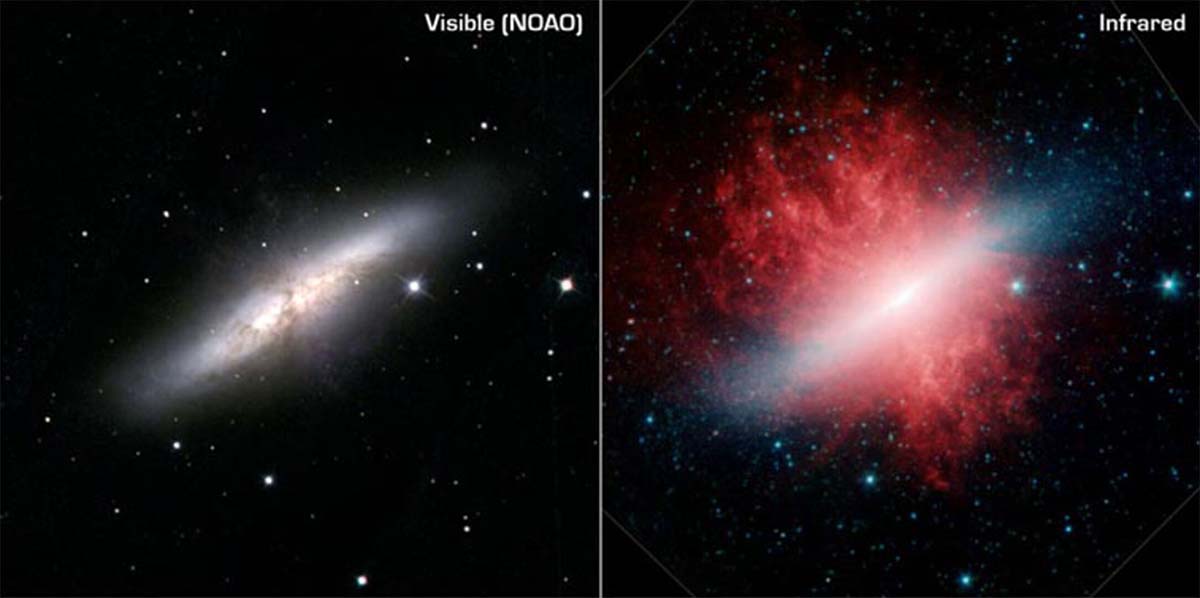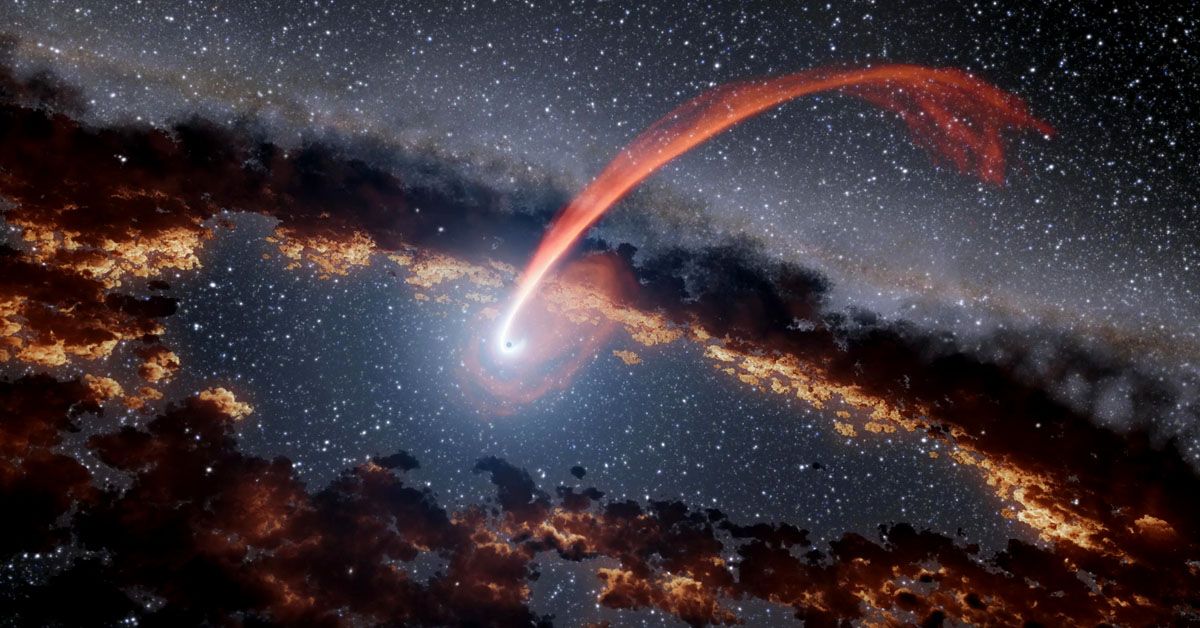Astronomy continues to unveil the incredible phenomena that take place in the vast reaches of our universe. One such captivating occurrence is the tidal disruption event (TDE), which transpires when a star gets too close to a supermassive black hole and is torn apart by gravitational forces. Recently, astronomers made a groundbreaking discovery, detecting the closest TDE ever observed in NGC 7392, a galaxy situated approximately 137 million light-years away from Earth. This particular TDE, labeled WTP14adbjsh, has brought forth new insights as it has been identified through infrared radiation, marking the first time a TDE has been directly detected at these wavelengths.
What is a Tidal Disruption Event (TDE)?
A tidal disruption event (TDE) is a rare and spectacular celestial occurrence that transpires when a star ventures too close to a supermassive black hole. As the star approaches the black hole, immense tidal forces generated by the black hole's gravity stretch and distort the star. Eventually, these forces become so strong that they overcome the star's self-gravity, ripping it apart in a process known as "spaghettification." The disrupted stellar material then forms an accretion disk around the black hole, with some of the matter spiraling inwards and eventually being swallowed by the black hole, while the remaining debris is ejected out into space at high velocities.

During this process, the accretion disk emits a bright flash of light across various wavelengths, ranging from X-rays to visible and infrared light. This emission of energy is what astronomers observe and study to learn more about the nature of TDEs and the black holes involved. TDEs are crucial for enhancing our understanding of black holes, their growth, and their influence on their host galaxies.
Discovery of WTP14adbjsh - The closest TDE
WTP14adbjsh, the recently discovered tidal disruption event (TDE) in the galaxy NGC 7392, is the closest TDE ever observed by astronomers. This groundbreaking find is particularly notable because it provides a unique opportunity to study TDEs in greater detail and glean new insights into the behavior and properties of both the disrupted stars and the supermassive black holes responsible for these events.
Importance of Infrared Radiation in Identifying TDEs
In the case of WTP14adbjsh, the detection of infrared radiation played a crucial role in identifying this TDE. Prior to this discovery, TDEs had primarily been detected using X-ray and optical observations. However, WTP14adbjsh's direct identification through infrared wavelengths marks a significant milestone, as it broadens our understanding of the possible emissions associated with TDEs.

The detection of TDEs in the infrared spectrum is of particular importance because it can unveil previously hidden events that may be obscured by dust or other intervening material. Infrared radiation can penetrate dust more effectively than optical or X-ray wavelengths, enabling astronomers to probe deeper into the heart of galaxies and uncover TDEs that might have otherwise been missed.
The Role of MIT Astronomers and NASA's NEOWISE Mission
The detection of WTP14adbjsh was made possible through the collaborative efforts of MIT astronomers and data obtained from NASA's Near-Earth Object Wide-field Infrared Survey Explorer (NEOWISE) mission. Launched in 2009, the NEOWISE mission has been scanning the entire sky in infrared wavelengths since 2010, providing valuable data that has led to numerous astronomical discoveries, including the identification of TDEs.
Kishalay De's Search Tool
An essential component in the detection of WTP14adbjsh was a search tool developed by MIT astronomer Kishalay De. This innovative tool was designed to sift through the vast amounts of archival data gathered by the NEOWISE mission, enabling astronomers to identify potential transient events, such as TDEs. By analyzing the data using De's search tool, the scientists were able to pinpoint the flash of infrared radiation emanating from NGC 7392 and conclusively determine that it was most likely a TDE.
Characteristics of the TDE in NGC 7392
WTP14adbjsh, the TDE detected in NGC 7392, exhibits several fascinating characteristics that contribute to our understanding of these events and the conditions under which they occur.
Supermassive Black Hole
At the center of NGC 7392 lies a supermassive black hole, estimated to be around 30 million times as massive as the sun. It is this colossal black hole that is responsible for the tidal disruption of the star, resulting in the observed TDE. The size of the black hole provides insights into the variety of black holes capable of producing TDEs and offers an opportunity to study the relationship between black hole mass and the properties of the disrupted star.

A Young, Star-Forming Galaxy
Another intriguing aspect of WTP14adbjsh is its occurrence within NGC 7392, a young, star-forming galaxy. This is in stark contrast to the majority of TDEs, which have predominantly been observed in quieter, more passive galaxies. The presence of a TDE in a star-forming galaxy like NGC 7392 suggests that conventional X-ray and optical surveys might have missed TDEs in similar environments due to the increased dust production, which can obscure the light emitted from the galactic core. This discovery highlights the need for exploring different wavelengths, such as infrared, to uncover additional TDEs in active, star-forming galaxies.
Implications of the Discovery for Future TDE Detection
The discovery of WTP14adbjsh and its unique characteristics have far-reaching implications for future TDE detection efforts. By expanding our understanding of the environments in which TDEs can occur and the wavelengths at which they can be observed, this groundbreaking finding paves the way for novel detection strategies and the potential to uncover more TDEs in the future.
The Potential for Missed TDEs in Star-Forming Galaxies
One of the most significant implications of WTP14adbjsh's discovery is the possibility that a considerable number of TDEs have been overlooked in star-forming galaxies. Traditional TDE detection methods, primarily relying on X-ray and optical observations, may struggle to pierce through the dust and debris prevalent in these active environments. This suggests that there may be a hidden population of TDEs waiting to be discovered in star-forming galaxies, highlighting the need for alternative detection techniques.
Infrared Band Searches for More Hidden TDEs
The successful identification of WTP14adbjsh using infrared radiation demonstrates the immense potential of infrared observations in uncovering TDEs obscured by dust or other intervening material. As infrared radiation is more capable of penetrating through dusty environments, searching in the infrared band could reveal many more TDEs that have remained hidden in active, star-forming galaxies. This discovery underscores the importance of incorporating infrared observations into future TDE detection strategies, ultimately leading to a more comprehensive understanding of these fascinating astronomical events and the diverse range of environments in which they can occur.
Sources: mit.edu / livescience.com / sciencealert.com / space.com












